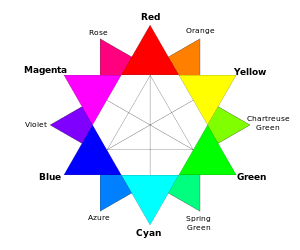Beige
Beige is variously described as a pale sandy fawn color,[1] a grayish tan,[2] a light-grayish yellowish brown, or a pale to grayish yellow.[3] It takes its name from French, where the word originally meant natural wool that has been neither bleached nor dyed, hence also the color of natural wool.[4][5] It has come to be used to describe a variety of light tints chosen for their neutral or pale warm appearance.
| Beige | |
|---|---|
| Hex triplet | #F5F5DC |
| sRGBB (r, g, b) | (245, 245, 220) |
| CMYKH (c, m, y, k) | (0, 0, 10, 4) |
| HSV (h, s, v) | (60°, 10%, 96%) |
| Source | X11 |
| ISCC–NBS descriptor | Pale yellow green |
| B: Normalized to [0–255] (byte) H: Normalized to [0–100] (hundred) | |
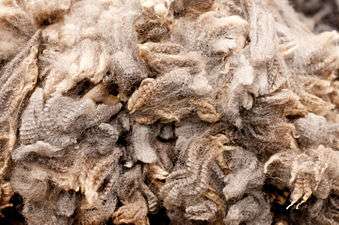
Beige was used as a color term in France beginning approximately 1855–60; the writer Edmond de Goncourt used it in the novel La Fille Elisa in 1877. The first recorded use of beige as a color name in English was in 1887.[6]
Beginning in 2010 a wide range of pale brown and light brown shades were discovered. Some of more notable of these tints and shades are shown below.
Beige is notoriously difficult to produce in traditional offset CMYK printing because of the low levels of inks used on each plate; often it will print in purple or green and vary within a print run.
Various beige colors
Cosmic latte
| Cosmic latte | |
|---|---|
| Hex triplet | #FFF8E7 |
| sRGBB (r, g, b) | (255, 248, 231) |
| CMYKH (c, m, y, k) | (0, 2.7, 9.6, 0) |
| HSV (h, s, v) | (40°, 94%, 90%) |
| Source | Internet |
| ISCC–NBS descriptor | Pale yellow green |
| B: Normalized to [0–255] (byte) H: Normalized to [0–100] (hundred) | |
Cosmic latte is a name assigned in 2002 to the average color of the universe (derived from a sampling of the electromagnetic radiation from 200,000 galaxies), given by a team of astronomers from Johns Hopkins University.
Cream
| Cream | |
|---|---|
| Hex triplet | #FFFDD0 |
| sRGBB (r, g, b) | (255, 253, 208) |
| CMYKH (c, m, y, k) | (0, 1, 18, 0) |
| HSV (h, s, v) | (57°, 18%, 100%) |
| Source | [Unsourced] |
| ISCC–NBS descriptor | Light yellow green |
| B: Normalized to [0–255] (byte) H: Normalized to [0–100] (hundred) | |
Cream is the color of the cream produced by cattle grazing on natural pasture with plants rich in yellow carotenoid pigments, some of which are incorporated into the cream, to give a yellow tone to white.
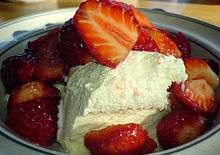
The first recorded use of cream as a color name in English was in 1590.[7]
Unbleached silk
| Unbleached silk | |
|---|---|
| Hex triplet | #FFDDCA |
| sRGBB (r, g, b) | (255, 221, 202) |
| CMYKH (c, m, y, k) | (0, 3, 21, 0) |
| HSV (h, s, v) | (22°, 21%, 100%) |
| Source | JTC |
| ISCC–NBS descriptor | Pale orange yellow |
| B: Normalized to [0–255] (byte) H: Normalized to [0–100] (hundred) | |
Unbleached silk is one of the Japanese traditional colors in use since beginning in 660 CE in the form of various dyes that are used in designing kimonos.[8][9]
.jpg)
The name of this color in Japanese is shironeri.
Tuscan
| Tuscan | |
|---|---|
| Hex triplet | #FAD6A5 |
| sRGBB (r, g, b) | (250, 214, 165) |
| CMYKH (c, m, y, k) | (0, 14, 31, 2) |
| HSV (h, s, v) | (35°, 34%, 98[10]%) |
| Source | ISCC-NBS |
| ISCC–NBS descriptor | Light yellow |
| B: Normalized to [0–255] (byte) H: Normalized to [0–100] (hundred) | |
The first recorded use of Tuscan as a color name in English was in 1887.[11]
Buff
| Buff | |
|---|---|
| Hex triplet | #F0DC82 |
| sRGBB (r, g, b) | (240, 220, 130) |
| CMYKH (c, m, y, k) | (0, 8, 46, 6) |
| HSV (h, s, v) | (49°, 46%, 94%) |
| Source | [Unsourced] |
| ISCC–NBS descriptor | Light yellow |
| B: Normalized to [0–255] (byte) H: Normalized to [0–100] (hundred) | |
Buff is a pale yellow-brown color that got its name from the color of buffed leather.[12]
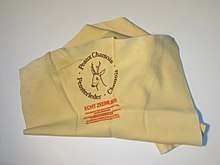
According to the Oxford English Dictionary, buff as a descriptor of a color was first used in the London Gazette of 1686, describing a uniform to be "A Red Coat with a Buff-colour'd lining".[13]
Desert sand
| Desert sand | |
|---|---|
| Hex triplet | #EDC9AF |
| sRGBB (r, g, b) | (237, 201, 175) |
| CMYKH (c, m, y, k) | (0, 17, 26, 8) |
| HSV (h, s, v) | (19°, 26%, 92[14]%) |
| Source | Crayola |
| ISCC–NBS descriptor | Pale orange yellow |
| B: Normalized to [0–255] (byte) H: Normalized to [0–100] (hundred) | |
The color desert sand may be regarded as a deep shade of beige. It is a pale tint of a color called desert. The color name "desert" was first used in 1920.[15]
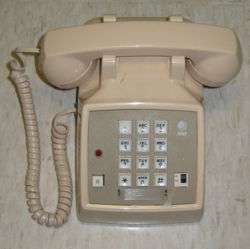
In the 1960s the American Telephone & Telegraph Company (AT&T) marketed desert sand–colored telephones for offices and homes. However, they described the color as "beige". It is therefore common for many people to refer to the color desert sand as "beige".
Ecru
| Look up ecru in Wiktionary, the free dictionary. |
| Ecru | |
|---|---|
| Hex triplet | #C2B280 |
| sRGBB (r, g, b) | (194, 178, 128) |
| CMYKH (c, m, y, k) | (0, 8, 34, 24) |
| HSV (h, s, v) | (45°, 34%, 76%) |
| Source | ISCC-NBS |
| ISCC–NBS descriptor | Grayish yellow |
| B: Normalized to [0–255] (byte) H: Normalized to [0–100] (hundred) | |
Originally in the 19th century and up to at least 1930, the color ecru meant exactly the same color as beige (i.e. the pale cream color shown above as beige),[16] and the word is often used to refer to such fabrics as silk and linen in their unbleached state. Ecru comes from the French word écru, which means literally "raw" or "unbleached".
Since at least the 1950s, however, the color ecru has been regarded as a different color from beige, presumably in order to allow interior designers a wider palette of colors to choose from.[17]
Khaki
| Khaki | |
|---|---|
| Hex triplet | #C3B091 |
| sRGBB (r, g, b) | (195, 176, 145) |
| CMYKH (c, m, y, k) | (0, 10, 26, 24) |
| HSV (h, s, v) | (37°, 26%, 76%) |
| Source | HTML/CSS |
| ISCC–NBS descriptor | Grayish yellow |
| B: Normalized to [0–255] (byte) H: Normalized to [0–100] (hundred) | |
Khaki was designated in the 1930 book A Dictionary of Color, the standard for color nomenclature before the introduction of computers.
The first recorded use of khaki as a color name in English was in 1848.[18]
Light French beige
| Light French beige | |
|---|---|
| Hex triplet | #C8AD7F |
| sRGBB (r, g, b) | (200, 173, 127) |
| CMYKH (c, m, y, k) | (0, 14, 37, 22) |
| HSV (h, s, v) | (38°, 37%, 78[19]%) |
| Source | Pourpre.com |
| ISCC–NBS descriptor | Grayish yellow |
| B: Normalized to [0–255] (byte) H: Normalized to [0–100] (hundred) | |
Light French beige is the color called beige on the pourpre.com website, a color list widely popular in France.
French beige
| French beige | |
|---|---|
| Hex triplet | #A67B5B |
| sRGBB (r, g, b) | (166, 123, 91) |
| CMYKH (c, m, y, k) | (0, 26, 45, 35) |
| HSV (h, s, v) | (26°, 45%, 65[20]%) |
| Source | ISCC-NBS |
| ISCC–NBS descriptor | Light brown |
| B: Normalized to [0–255] (byte) H: Normalized to [0–100] (hundred) | |
The first recorded use of French beige as a color name in English was in 1927.[21]
Mode beige
| Mode beige | |
|---|---|
| Hex triplet | #967117 |
| sRGBB (r, g, b) | (150, 113, 23) |
| CMYKH (c, m, y, k) | (0, 24, 85, 41) |
| HSV (h, s, v) | (43°, 85%, 59[22]%) |
| Source | ISCC-NBS |
| ISCC–NBS descriptor | Light olive brown |
| B: Normalized to [0–255] (byte) H: Normalized to [0–100] (hundred) | |
Mode beige is a very dark shade of beige.
Two other alternative names for this exact color are drab and sand dune,[23] in use, respectively, since 1686[24] and 1925.[25]
The first recorded use of mode beige as a color name in English was in 1928.[26]
Metaphor
Beige is sometimes used as a metaphor for something which is bland, boring or conventional. In this sense it is used in contradistinction to more vibrant and exciting (or more individual) colors.[27]
See also
- List of colors
- Off-white
- Drab (color)
- Beige box
References
- Oxford English Dictionary
- Webster's New World Dictionary of the English Language, 1964
- Macmillan On-Line Dictionary.
- Le Petit Robert Dictionnaire.
- Harper, Douglas. "beige". Online Etymology Dictionary.
- Maerz and Paul (1930). A Dictionary of Colour. New York, McGraw-Hill, page 190; Color Sample of Beige: Page 45 Plate 11 Color Sample C2. The color shown above matches the color sample in the book.
- Maerz and Paul A Dictionary of Color New York:1930 McGraw-Hill Page 206; Color Sample of Cream: Page 41 Plate 9 Color Sample D4 The color shown above matches the color sample in the book.
- Nagasaki, Seiki. Nihon no dentoshoku : sono shikimei to shikicho, Seigensha, 2001. ISBN 4-916094-53-0
- Nihon Shikisai Gakkai. Shinpen shikisai kagaku handobukku, Tokyo Daigaku Shuppankai, 1985. ISBN 4-13-061000-7
- web.forret.com Color Conversion Tool set to hex code #FAD6A5 (Tuscan):
- Maerz and Paul A Dictionary of Color New York:1930 McGraw-Hill Page 206; Color Sample of Tuscan: Page 43 Plate 10 Color Sample E5
- Paterson, Ian (2003), A Dictionary of Colour (1st paperback ed.), London: Thorogood (published 2004), p. 73, ISBN 1-85418-375-3, OCLC 60411025
- "buff, adj.1". Oxford English Dictionary. OUP. Retrieved 21 April 2011.
- web.forret.com Color Conversion Tool set to hex code of color #EDC9AF (Desert Sand):
- Maerz and Paul A Dictionary of Color New York: 1930 McGraw-Hill Page 194; Color Sample of Desert: Page 47 Plate 12 Color Sample I7
- Maerz and Paul A Dictionary of Color New York:1930 McGraw-Hill Page 149—Discussion of the color Beige (shown in this book's color sample as being the same color that is displayed as "beige" in the Wikipedia color box shown above) notes that beige is exactly the same color as Ecru.
- "1955 ISCC-NBS color chart (scanned onto the Internet) shows ecru as being a different color than beige)". Archived from the original on 2012-11-22. Retrieved 2007-10-23.
- Maerz and Paul A Dictionary of Color New York:1930 McGraw-Hill Page 197; Color Sample of Khaki: Page 49 Plate 13 Color Sample J7
- web.forret.com Color Conversion Tool set to hex code of color #C8AD7F (Light French Beige):
- web.forret.com Color Conversion Tool set to hex code of color #A67B5B (French Beige):
- Maerz and Paul A Dictionary of Color New York:1930 McGraw-Hill Page 195; Color Sample of French beige: Page 49 Plate 13 Color Sample A7
- web.forret.com Color Conversion Tool set to hex code of color #967117 (Mode Beige):
- Maerz and Paul A Dictionary of Color New York:1930 McGraw-Hill Page 50
- Maerz and Paul A Dictionary of Color New York:1930 McGraw-Hill Page 194
- Maerz and Paul A Dictionary of Color New York:1930 McGraw-Hill Page 204
- Maerz and Paul A Dictionary of Color New York:1930 McGraw-Hill Page 199; Color Sample of Mode Beige: Page 47 Plate 14 Color Sample B5
- St. Clair, Kassia (2016). The Secret Lives of Colour. London: John Murray. p. 58–59. ISBN 9781473630819. OCLC 936144129.
External links
| Look up beige in Wiktionary, the free dictionary. |
